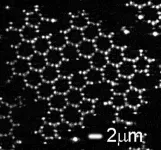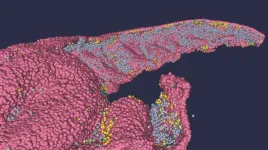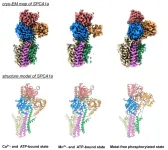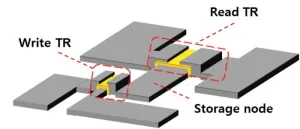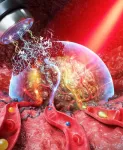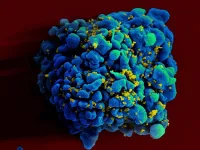(Press-News.org) Graphene is the strongest of all materials. On top of that, it is exceptionally good at conducting heat and electrical currents, making it one of the most special and versatile materials we know. For all these reasons, the discovery of graphene was awarded the Nobel Prize in Physics in 2010. Yet, many properties of the material and its cousins are still poorly understood – for the simple reason that the atoms they are made up of are very difficult to observe. A team of researchers from the University of Amsterdam and New York University have now found a surprising way to solve this issue.
Two-dimensional materials, consisting of a hyper-thin single layer of atomic crystal, have attracted a lot of attention recently. This well-deserved attention is mainly due to their unusual properties, very different from their three-dimensional ‘bulk’ counterparts. Graphene, the most famous representative, and many other two-dimensional materials, are nowadays researched intensely in the laboratory. Perhaps surprisingly, crucial to the special properties of these materials are defects, locations where the crystal structure is not perfect. There, the ordered arrangement of the layer of atoms is disturbed and the coordination of atoms changes locally.
Visualizing atoms
Despite the fact that defects have been shown to be crucial for a material’s properties, and they are almost always either present or added on purpose, not much is known about how they form and how they evolve in time. The reason for this is simple: atoms are just too small and move too fast to directly follow them.
In an effort to make the defects in graphene-like materials observable, the team of researchers, from the UvA-Institute of Physics and New York University, found a way to build micrometre-size models of atomic graphene. To achieve this, they used so-called 'patchy particles’. These particles – large enough to be easily visible in a microscope, yet small enough to reproduce many of the properties of actual atoms – interact with the same coordination as atoms in graphene, and form the same structure. The researchers built a model system and used it to obtain insight into defects, their formation and evolution with time. Their results were published in Nature Communications this week.
Building graphene
Graphene is made up of carbon atoms that each have three neighbours, arranged in the well-known ‘honeycomb’ structure. It is this special structure that lends graphene its unique mechanical and electronic properties. To achieve the same structure in their model, the researchers used tiny particles made of polystyrene, decorated with three even tinier patches of a material known as 3-(trimethoxysilyl)propyl – or TPM for short. The configuration of the TPM patches mimicked the coordination of carbon atoms in the graphene lattice. The researchers then made the patches attractive so that the particles could form bonds with each other, again in analogy with the carbon atoms in graphene.
After being left alone for a few hours, when observed under a microscope the ‘mock carbon’ particles turned out to indeed arrange themselves into a honeycomb lattice. The researchers then looked in more detail at defects in the model graphene lattice. They observed that also in this respect the model worked: it showed characteristic defect motifs that are also known from atomic graphene. Contrary to real graphene, the direct observation and long formation time of the model now allowed the physicists to follow these defects from the very start of their formation, up to the integration into the lattice.
Unexpected results
The new look at the growth of graphene-like materials immediately led to new knowledge about these two-dimensional structures. Unexpectedly, the researchers found that the most common type of defect already forms in the very initial stages of growth, when the lattice is not yet established. They also observed how the lattice mismatch is then ‘repaired’ by another defect, leading to a stable defect configuration, which either remains or only very slowly heals further to a more perfect lattice.
Thus, the model system not only allows to rebuild the graphene lattice on a larger scale for all sorts of applications, but the direct observations also allow insights into atomic dynamics in this class of materials. As defects are central to the properties of all atomically thin materials, these direct observations in model systems help further engineer the atomic counterparts, for example for applications in ultra-lightweight materials and optical and electronic devices.
END
Graphene grows – and we can see it
2023-03-24
ELSE PRESS RELEASES FROM THIS DATE:
Human Brain Project researchers develop new full-scale 3D structural model of the human hippocampus
2023-03-24
A new high resolution model of the CA1 region of the human hippocampus has been developed by the Institute of Biophysics of the Italian National Research Council (CNR-IBF) and University of Modena e Reggio Emilia (UNIMORE), part of the Human Brain Project. The single-cell resolution model, which replicates the structure and architecture of the area, along with the position and relative connectivity of the neurons, was developed from a full-scale dataset of high resolution images. The dataset is available in the BigBrain Atlas and it will be soon available on EBRAINS. According to the study, published in the journal ...
The first report on the incidence of moderate and severe OHSS in China
2023-03-24
Moderate and severe ovarian hyperstimulation syndrome (OHSS) developed in 1.14% of Chinese women of reproductive age between 2013 and 2017. Moreover, women under 35 years of age receiving assisted reproductive technology (ART) should be monitored for OHSS more closely compared with other age groups.
These findings were concluded from the first report on the incidence of moderate and severe OHSS in China recently published in Health Data Science, a Science Partner Journal.
OHSS constitutes the most severe iatrogenic ...
Cryo-electron microscopy captures structure of a protein pump
2023-03-24
Hailey-Hailey disease is a rare, inherited condition characterized by patches of blisters appearing mainly in the skin folds of the arm pits, groin and under the breasts. It is caused by a mutation in the gene that codes for a specific protein involved in the transportation of calcium and manganese ions from the cell cytoplasm and into a sac-like organelle called the Golgi apparatus. Scientists at Tohoku University, together with colleagues in Japan, have uncovered some aspects of this protein's structure that could help researchers understand how it works. The findings, published ...
AI “brain” created from core materials for OLED TVs
2023-03-24
ChatGPT's impact extends beyond the education sector and is causing significant changes in other areas. The AI language model is recognized for its ability to perform various tasks, including paper writing, translation, coding, and more, all through question-and-answer-based interactions. The AI system relies on deep learning, which requires extensive training to minimize errors, resulting in frequent data transfers between memory and processors. However, traditional digital computer systems' von Neumann architecture separates the storage and computation of information, resulting in increased ...
Contrast-enhancing agents to overcome physical and practical challenges of photoacoustic imaging
2023-03-24
A research team at POSTECH led by Professor Chulhong Kim (Department of Electrical Engineering, Department of Convergence IT Engineering, and Department of Mechanical Engineering) has compiled the findings from innovative research on contrast-enhanced photoacoustic imaging conducted over the last four years. These findings were recently featured in Chemical Reviews, a highly authoritative journal.
For decades, the scientific community has been investigating the potential of photoacoustic imaging as a biomedical imaging modality. However, despite its enhanced optical contrast and ultrasonic spatiotemporal resolution, photoacoustic imaging faces ...
A readily available dietary supplement may reverse organ damage caused by HIV and antiretroviral therapy
2023-03-24
FINDINGS
MitoQ, a mitochondrial antioxidant that is available to the public as a diet supplement, was found in a mouse study to reverse the detrimental effects that HIV and antiretroviral therapy (ART) have on mitochondria in the brain, heart, aorta, lungs, kidney and liver.
The researchers used a molecular method to measure the ratio of human and murine mitochondrial (mtDNA) to nuclear DNA (ntDNA) ratio, a measure of mitochondrial dysfunction. Reduction in this ratio reflects mitochondrial dysfunction. Compared to uninfected mice, HIV infected mice treated with ART had mitochondrial dysfunction in the human immune cells in the brain, ...
New research project aims to set standardized approach to lipoprotein(a) management
2023-03-24
DALLAS, March 24, 2023 — High levels of lipoprotein(a) [Lp(a)] are an independent, predominantly inherited and causal risk factor for cardiovascular disease, the leading cause of death and disability worldwide, according to a recent American Heart Association scientific statement. It is estimated that 1 in 5 Americans have high Lp(a) levels. Studies have shown that elevated Lp(a) — a low-density lipoprotein variant containing a protein called apolipoprotein(a) — is a risk factor for atherosclerosis (buildup of fatty material in artery walls) and related ...
Dr. Natalie Uy named chief of division of pediatric nephrology at Weill Cornell Medicine and NewYork-Presbyterian Komansky Children’s Hospital
2023-03-24
Dr. Natalie Uy, a leading pediatric nephrologist, has been named chief of the Division of Pediatric Nephrology in the Department of Pediatrics at Weill Cornell Medicine and NewYork-Presbyterian Komansky Children’s Hospital, effective April 17.
The Division of Pediatric Nephrology provides compassionate care for newborns, children and young adults with complex kidney diseases and urologic conditions. Services provided include dialysis and kidney transplantation for patients with end-stage kidney disease.
Dr. Uy was recruited to Weill Cornell Medicine as an assistant professor of pediatrics ...
Use age, not weight, to screen for diabetes
2023-03-24
· All racial/ethnic minority groups develop diabetes at lower weights than white adults
· Screening all adults aged 35 to 70 years identifies the greatest proportion of adults with prediabetes and diabetes
· A ‘huge portion’ of the U.S. population has undiagnosed prediabetes or diabetes
CHICAGO --- Focus on age, not weight, to capture the greatest number of people in all racial and ethnic groups with prediabetes and diabetes, reports a new Northwestern Medicine study.
Screening all adults ...
Framework helps local planners prepare for climate pressures on food, energy & water systems
2023-03-24
By David Chandler
As the world faces increasingly extreme and frequent weather events brought on by climate change – such as droughts, floods, heatwaves, and wildfires – critical civic resources such as food, water, and energy will be impacted. Local and regional planners need to anticipate those impacts and evaluate what measures can be taken to prepare.
Now, a multidisciplinary, multi-institutional team of researchers has built a detailed framework to provide guidance to these planners. After two years of in-depth consultation ...
